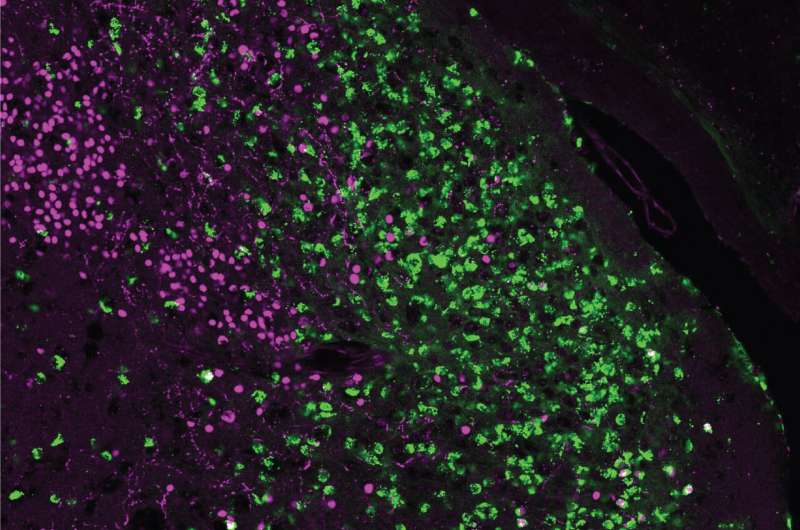November 30, 2023 feature
This article has been reviewed according to Science X's editorial process and policies. Editors have highlighted the following attributes while ensuring the content's credibility:
fact-checked
peer-reviewed publication
trusted source
proofread
Study shows that distinct subpopulations of cells in the mouse amygdala influence different social behaviors

Mammals can engage in a wide range of cooperative and aggressive social behaviors. These behaviors are known to be influenced by different neural circuits, yet the molecular underpinnings of these circuits and their development over time remain poorly understood.
Researchers at New York University Grossman School of Medicine and Children's National Hospital recently carried out a study exploring the unique functions of molecularly different cell populations in the amygdala, brain region that regulates fear-related, automatic and instinctual behaviors. Their paper, published in Nature Neuroscience, shows that two transcriptionally different populations of amygdala cells produce different social behaviors in male mice.
"Previous work in Dr. Joshua Corbin's lab including my Ph.D. dissertation were huge inspirations for the project," Julieta Lischinsky, co-author of the paper, told Medical Xpress.
"We had previously identified two developmentally distinct subpopulations that possessed different molecular and electrophysiological identities and we were intrigued to better understand in Dr. Dayu Lin's lab whether the functional role and in vivo responses of these subpopulations would differ. We were also inspired by outstanding work from previous groups researching the medial amygdala function and connectivity."
The primary objective of the recent study carried out by Lischinsky and her colleagues was to investigate how the interplay between innate natural development (nature) and life experiences (nurture) shapes neuronal responses to social sensory cues in mice and potentially other mammals.
In their experiments, the researchers set out to understand whether the development history (developmental lineage) of cells in the amygdala of mice predicted their function while the animals engaged in social behaviors.
"To find out the role of different medial amygdala subpopulations, we decided to use in vivo functional tools on freely moving male mice," Lischinsky explained. "This allowed us to address two research questions: During which behaviors are different cell subpopulations activated? And can these subpopulations be required for social behaviors?"
The researchers measured changes in the male mice's neuronal activity using a technique known as fiber photometry, which unveils variations in activity by making cells more or less fluorescent. Subsequently, the team used chemogenetic tools to activate or silence cells of interest in the amygdala, so that they could observe the social behavior of mice following their interventions.
"Our study uncovered a hardwired circuit in male mice for processing male sensory information and aggression in the amygdala," Lischinsky said. "We revealed that medial amygdala neuronal responses, function and circuit connectivity are developmentally defined and identified how experience can shape social representations."
The experiment carried out by Lischinsky and her colleagues allowed them to identify a specific neuronal circuit in the amygdala that contributes to aggressive behaviors in male mice. The team's observations also appear to confirm the key role of life experiences in shaping the development of cells in the amygdala, and thus also fostering distinct social behaviors.
This recent study could soon pave the way for further chemogenetic studies closely examining how molecularly different neuronal populations influence the social behaviors of mammals, including humans. This could ultimately help to better understand the neural underpinnings of psychiatric and developmental disorders that are characterized by aggressive tendencies or difficulties in interacting with others.
"Understanding the developmental and circuit mechanisms for social behaviors is crucial for the improvement of therapeutic approaches for the treatment of disorders characterized by deficits in social interactions, such as autism spectrum disorder and conduct disorders, which can be seen in children and adolescents," Lischinsky added.
"Future research in the area will involve further understanding the role of amygdala cell subpopulations in female mice during social behaviors including aggression, as well as the connectivity of these amygdala cells to other regions in the social behavior network, a set of brain structures involved in social behaviors."
More information: Julieta E. Lischinsky et al, Transcriptionally defined amygdala subpopulations play distinct roles in innate social behaviors, Nature Neuroscience (2023). DOI: 10.1038/s41593-023-01475-5
© 2023 Science X Network




















